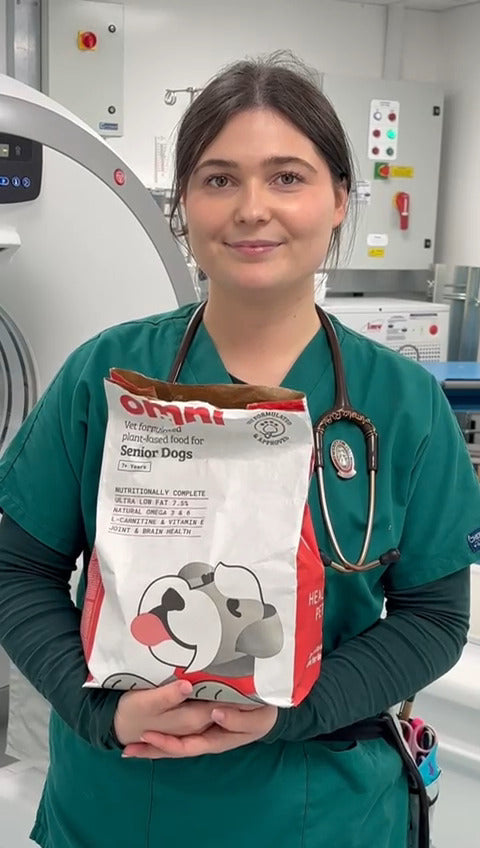My Dog Keeps Sighing… (Do Dogs Get Sad?) | Ask a Vet | Omni.pet

My Dog Keeps Sighing… Do Dogs Get Sad?
Laura from Manchester emailed us to ask: “Why does my Labrador keep sighing? It’s almost like she’s upset or bored. I don’t know what to do about it!”
Bella, her 5-year-old Labrador, had been sighing frequently, particularly when Laura wasn’t paying her much attention. Laura wanted to know if Bella’s sighs were a sign that she was sad or if there was another reason behind the behaviour.
In this article, our Chief Veterinarian and Omni Co-Founder, Dr. Guy MRCVS, explains why dogs sigh, what it could mean, and when to take note of the behaviour and seek further veterinary attention.
Our Chief Veterinarian, Dr. Guy MRCVS, Answers
Firstly, yes, dogs absolutely do get sad!
Dogs, like almost all animals, are sentient and intelligent beings with thoughts, feeling, and emotions. Like many other animals, too, dogs feel pleasure, pain, joy, sadness, and can even suffer depression.
However, sighing is not necessarily a sign that your dog is sad or depressed - there are many other explanations, too.
While dogs may not express emotions in exactly the same way we do, sighing can be a form of communication for them.
Reasons Why Your Dog Is Sighing
There are many reasons why dogs sigh, and it’s usually a part of their body language, just like wagging their tail or barking. Here are some common interpretations of sighing in dogs and how to recognise what your dog might be feeling.
1. Relaxed or Sleepy Sighing
One of the most common reasons for sighing is contentment. When your dog is feeling relaxed or sleepy, they might let out a deep sigh as they settle down. This is often accompanied by a relaxed posture—your dog may be lying down with their eyes partially closed, clearly at ease.
Key signs your dog is sighing out of relaxation:
- They’re lying down or resting in a comfortable position.
- Their posture is loose, and they may be closing their eyes or drifting off to sleep.
In this case, sighing is nothing to worry about - it’s just a sign your dog is calm and happy!
2. Sighing Due to Boredom
Dogs also sigh when they’re bored or when they’ve failed to get the attention they were seeking. If your dog has been trying to engage you in play or activity and isn’t successful, they may give a sigh, almost like they’re resigning themselves to the fact that they won’t get what they want. This type of sigh is often more deliberate and might be followed by your dog sitting up or glancing at you expectantly - a bit like a cheeky child!
Key signs your dog is sighing out of boredom:
- They’ve just tried to get your attention (e.g., bringing you a toy, nudging you).
- They sit up or lie near you, watching you closely.
If your dog is sighing from boredom, it’s a sign they need more mental or physical stimulation. Try engaging them with a toy or take them out for a walk to burn off some energy.
3. Sighing Due to Anxiety or Stress
In some cases, sighing can be a sign of anxiety or stress. When dogs are feeling tense, they may let out a sigh as part of their coping mechanisms. You’ll often notice that this type of sigh is accompanied by other anxious behaviours, such as a stiff posture, ears pinned back, or restlessness.
Key signs your dog is sighing due to anxiety:
- Their posture is stiff, or they appear restless and unable to settle.
- They have their ears back, and their body language is tense.
If your dog is sighing out of anxiety, it’s important to identify the cause of their stress and address it. This might include creating a calm environment or seeking advice from your vet on how to manage your dog’s anxiety.
To combat stress, our vets recommend supplementing with a Stress and Anxiety soft chew once per day, packed with natural ingredients to boost your dog’s serotonin levels and live a more peaceful, settled, and happier life!
When to Be Concerned
While sighing is usually a harmless behaviour, there are a few cases where it might indicate something more serious. If your dog’s sighing is accompanied by changes in their behaviour, such as lethargy or a loss of appetite, it’s worth keeping an eye on them. Additionally, excessive sighing could be a sign of underlying boredom, stress, or even a medical issue if it’s paired with other unusual behaviours.
You should seek veterinary advice if:
- Your dog’s sighing becomes excessive or is accompanied by other signs of stress or illness.
- The sighing is part of a broader pattern of behaviour that seems unusual for your dog.
How to Address Excessive Sighing
If you’re concerned that your dog’s sighing is due to boredom, anxiety, or a need for attention, here’s how you can help:
1. Engage Your Dog with Activities
Provide plenty of physical exercise and mental stimulation to keep your dog occupied. Long walks, interactive toys, and training exercises can all help reduce boredom-related sighing.
2. Create a Calm Environment
If your dog is sighing due to anxiety, consider creating a quiet, stress-free space for them to relax. Calming aids like a soothing blanket or a quiet corner of the house may help reduce their anxiety.
3. Make Use of Stress & Anxiety Supplements!
In many cases, stress and anxiety supplements designed for dogs can be beneficial. That’s why our vets developed Omni Rescue’s Stress and Anxiety Supplement which contains safe, natural and effective ingredients like valerian root or L-tryptophan (which dogs turn into serotonin), which in turn help to ease anxiety and promote relaxation.
4. Positive Reinforcement
If your dog is sighing for attention, try not to reinforce the behaviour by responding immediately, as this can teach them that persistent sighing is a positive behaviour that is rewarded by play sessions. Instead, offer them attention or engage them in activities on your terms, reinforcing positive behaviours.
Speak with a Vet If…
You should speak to a vet if:
- Your dog’s sighing is accompanied by other signs of distress, such as pacing, whining, or changes in appetite.
- The sighing seems to indicate discomfort, particularly if your dog appears restless or unsettled.
If you’re noticing any of these signs, it’s a good idea to consult with a vet to ensure there’s no underlying medical or emotional issue that needs addressing.
Thoughts from Dr Guy MRCVS
As dog lovers and guardians, it’s natural to worry about our furry friends, especially when they display abnormal symptoms that can’t be easily explained. That’s why, when I founded Omni, I knew that I wanted to keep vet consultation free and accessible at the heart of the business.
If you’re understandably worried about your dog, but you don’t think you need to take them to the vets urgently, I highly recommend getting some friendly, professional advice from one of our team.
Explore some of the frequently asked questions in our Ask a Vet series
Got a question for the Ask a Vet team?
Submit your question via email to woof@omni.pet. We’ll get back to you as soon as we can, and, if suitable, post the response here to help others, too!
Disclaimer: Whilst the advice given here is based on medical experience from our experts, and scenarios we do encounter during our career - we do not give tailored or specific advice for individual pets - please seek assistance from your in person vet as a first point of call with any issues your pet is having which are a cause for concern as soon as possible.







 85 Great Portland Street, 1st Floor, London, W1W 7LT United Kingdom
85 Great Portland Street, 1st Floor, London, W1W 7LT United Kingdom